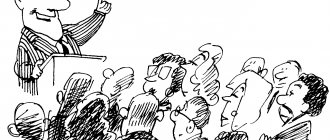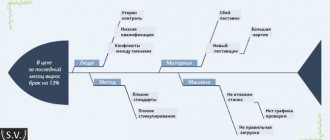Speaking about team building, professionals say that team projects often fail in the early stages. The reason for this is a lack of understanding of what a team is, how it is formed and how it functions. Situations when one person succeeds in a chosen activity can, roughly speaking, be counted on one hand. Not everyone can be talented and skillful in everything related to a project - that is why teams are created in which a variety of specialists work. If the organization of the team’s work is structured correctly, the team can move mountains where an individual cannot take even a step.
But despite the serious benefits that team building promises, there are also certain risks. For example, if failure befalls one person, the losses are minimal, because they concern only him, and he, most likely, was prepared in advance for the fact that he could fail. And when it comes to a team project, the results concern all participants. As a result, the project dies in agony for all to see.
Of course, this is just an example, because there are a huge number of teams that achieve their goals. Within such teams there is complete mutual understanding and support, respect and trust. The result is successful project implementation. But what's the matter? Are these teams lucky or have they found their “philosopher’s stone” that turns anything into gold?
In fact, everything is much simpler, and almost everyone can learn how to properly organize the work of a team. It's all about team building, built on common sense, awareness and a professional approach. Let's figure out what a real team is, what it takes to build one, and how to keep it alive and running.
Only a professional in team building can create a strong team
Everyone already understands that to create a great marketing plan or a stunning blockbuster you need to be a professional marketer or director. Despite this, many teams are formed by people who have no idea how to do it correctly; people with no experience or skills.
Team building is a skill, and in team building it is much more important than any technical, marketing or any other skills. Team building must be approached with intelligence, deference and respect. If you don't know how to select people for a team, how to set tasks and achieve goals, how to resolve conflicts at work, or what to do when productivity is low, your first step towards building a team will be to master these skills.
You need to master them in the same way as any others - using auxiliary tools, such as topical articles and books, video courses, audio seminars, and Internet sites. It is also worth studying the experience of other teams and even meeting with their leaders and ordinary participants.
To learn how to create teams, you need to show a fair amount of patience and endurance. The information is there, but before using it you need to comprehend and consolidate it. Imagine a surgeon constantly looking at a textbook or asking an assistant for tips during an operation - do you think he is a professional? It’s exactly the same here: without mastering the basic skills and without developing the necessary qualities, it’s dangerous to take on the task of forming a team.
You can try the trial and error method and learn everything in practice. But using this method to develop team skills is fraught with loss of reputation and putting yourself in an unfavorable light. People often ruin the lives of themselves and others by being careless about team building. Some people act at random, thinking that they will learn everything by doing. But this is analogous to going to sea in a storm to learn to swim. If you're lucky, you'll stay alive, but if not, you'll drown yourself and drag the rest with you.
Therefore, we advise you to initially thoroughly work on yourself and understand what team building is. The training you take will be the first step. Then you can read several books from the list given in the introduction and familiarize yourself with other materials. This way you will form a basis for further training. But remember that you will need to learn even when you form your first team. Professional development is the responsibility of any manager, leader and person striving for development.
And to find out whether you are ready for practical actions, you can use the so-called “rule of thumb”. If you yourself think that you would be happy to join a team with a leader like you, then you are ready. But if you have doubts about working in such a team, this suggests that it is too early to create your own team. Pay attention to the nuances that cause the greatest concern and work through them. You should not think that this is an exaggeration, because the experience of professionals shows that only a comprehensively developed person who is confident in his knowledge can manage a team.
How to reduce delivery time?
The first thing that came to mind was why are we returning tasks
? Why do backend, frontend and QA understand a task differently? Why do views differ? We came to the conclusion that we found the project manager to blame for not describing the tasks completely, and told the PM to describe the tasks more fully so that everyone understood what was meant.
We had three backend teams doing the planning. We involved testers and front-end developers in planning
, but for 3 teams there were only 2 front-end developers and 2 testers. Often it was not possible to call them because someone had to work.
Divided tasks separately into frontend and backend
, in order to submit them for development in parallel, test them faster and not wait for the entire chain.
We have tried all the solutions. As a result, the time was reduced, but we were still not satisfied.
We were thinking what to do next. There are many companies and practices on the market, and we began to study, look, dig and reached the feature-team.
First, the team is formed, and only then the project is developed
A fairly common occurrence is when people choose projects that interest them, develop plans, collect piles of papers, and only then begin to create a project team. At first glance, this approach seems correct, but in reality everything is different.
Until there is a team, choosing a feasible project is very, very difficult. The general idea, of course, is needed, because... indicates direction, but details should only be determined after the team has been formed. In order not to be unfounded, we will consider two options for the development of events.
Let's imagine that we took the first path, where a project is first created and then a team is formed. The work is progressing, the idea is inspiring, various nuances of the project are being considered, and the need for specific specialists is being clarified. It seems that everyone is ready and we are starting to form a team. For example, we decide to create a computer game, and, having some knowledge, we take on the functions of a designer and developer, and select two more specialists - an artist and a programmer. Music and sound will be licensed. The project itself is quite simple - a regular 3D action. We firmly believe in the success of the new game, and the specifications clearly show the achievability of the result. According to our estimates, the new product will be ready in six months.
Quite a reasonable plan, isn't it? But this is an illusion. At first, the plan seems feasible, and many developers choose a similar strategy year after year. It happens, of course, that success is achieved, but this is the exception rather than the norm. But what do we actually see?
Month after month we have to look for a smart 3D programmer who will agree to work on our terms, but we never find him. All we have is a 2D programmer starting to master 3D. Our artist cannot draw a high-quality texture, even if we threaten him with a 16mm machine gun. He is, of course, good in his 2D, but the stunning new product will suffer greatly.
As a result, we have to somehow try to make candy from what we have. Our pros, no matter how hard they try, cannot make 3D. Something looms on the screen, but the engine is glitchy, and the game is worse than the antediluvian “Prince of Persia” (no offense to connoisseurs). Seeing all this, our team has stopped even trying to meet the deadlines and follow the design agreed upon at the very beginning. Everyone has their own ideas that they want to realize. In addition, no one takes project documentation seriously.
We decide to take the bull by the horns: we lay out who should do what and how, and give a lot of detailed instructions and tasks. But each team member continues to see the game in his own way, which is why there is no unity in the team. Its absence slows down the project and misses deadlines. Our programmer and artist create the appearance of work, but in fact no longer believe in the success of the project. And then we find out that one of them has even joined a third-party project, and ours has become completely unimportant for him. The ending is a complete failure of the project and disappointment in one’s abilities.
So what was the mistake of our team building? The fact is that we relied on designing a quality product for gamers, considering it a sufficient condition for achieving success. But in team projects this, as they say, doesn’t work. To implement a team project, you need to select the right people for the team. The wrong command leads to the need for constant monitoring. In the right team, such a need does not arise, because individual responsibility becomes the norm for everyone.
Another disadvantage of the first approach is that the potential of team members is not optimally used. It would be much more effective if the game was developed based on the abilities of our people. Specialists give their best when they do what they can do. The team is somewhat of a limiting factor, so the project must adapt to it.
Now we have become smarter and have taken the second path, where a team is first formed, and then a project is created. We have a general concept of the plan, but we are not discussing the details yet. Our primary goal is to build a team, which is why we invest our time in choosing the best people to implement the idea. The choice of participants is not limited by any limits, because We haven't specified the details yet. Our main focus is getting to know people and then selecting those who we think will work well with others. When the team is complete, we do the same brainstorming, thinking through the features and architecture of the game, relying on the capabilities of the team.
Regardless of the characteristics of the project and the area to which it belongs, its success is determined by the dedication of people to the team and the common cause. And team members will be much more committed if they have the opportunity to contribute to the concept, as well as the chance to make the most of their skills. All team members understand that their work will be visible, tangible and valuable. The final result in this case is the growth of the project, general enthusiasm, dedication of people to the cause, and a high probability of success. It is quite possible that such a team will work on other projects in the future.
The right choice of people determines the success of the team
If we turn to any book on top management, we will immediately see that selecting people for the team is the most important and critical process. If the wrong approach was used when forming a team, even the best manager in the world will not be able to save it from collapse and guarantee effective work in the team. If the team breaks up, a smart specialist removes “extra” people from it and replaces them with new ones - more suitable ones.
Under no circumstances should you take on your team anyone who is interested in this. It often takes months to select the best people. For this purpose, personnel departments are created that scrutinize each candidate. The main limiting factor here is your ability to find, attract and select the most suitable people for your team. If it is not possible to form a team, the project should be postponed. By the way, you can find out all the details about project management here, but we will not focus on this and will tell you in more detail about what to consider when choosing people for team work.
A few words about Pavel Markasyan
Pavel Markasyan is HR Director of Trionika with 10 years of experience in training and personnel management, certified coach (ECF), author of several Internet projects using PowerPoint presentation templates and founder of PowerPoint Academy.
Pavel has experience in insurance, hotel business and IT. Pavel worked as a business coach at PZU Ukraine, in the Hospitality sector at the Fairmont Grand Hotel Kyiv, Fairmont Chicago, Hyatt Regency Kyiv and then at the IT company Wentrum.
Pavel currently works as HR Director at Trionika. In addition, he is a professional PowerPoint presentation creator and has released several of his projects:
- PowerPointBase.com
- PowerPointStore.com
- PPSlides.com
- MagicDiagram.com
The key to team success is only team players
In building a successful and effective team, you need to be guided by the most important principle of selecting people: the team should have team players, not loners. And here's a great example: at the 1980 Winter Olympics, the American national hockey team defeated the USSR team with a score of 4: 3 and took gold, making a splash in the world of sports. The surprising thing is that even before the Olympics, the USSR team defeated the USA team with a score of 10:3. After the Games, the American coach was asked how he achieved victory. Answering, he said that he conducted several psychological tests on his team, identified self-centered players and selected only those who maintain team spirit.
The point is that team players, by accepting, understanding and respecting individual differences, strive to achieve a common result, not their own. They certainly enjoy praise and recognition, but their ambition is about the team goal, not their ego. Team players will recheck their work a hundred times and make a thousand changes to it - just so that the project is a success and the team wins. Think of the human body: there are so many cells, organs and systems, but they all work towards a common goal - to keep the body healthy and alive.
Another advantage of team players is that they, on their own initiative and willingly, take responsibility for achieving the desired result, and their work does not require strict control and management. No problem will be left unattended, because... team players will find any shortcomings and fix them. And their motivation is the fact that they are INVOLVED in the project - it is THEIR project.
Even the brightest individuality gives way to strength of character. Team play is personal dignity and full responsibility for everything that concerns the team. Team play is about honesty and the complete absence of mistrust and suspicion. Team play is about team players who value respect and avoid conflict at work. We also advise you to familiarize yourself with our material on the topic of project team management, personal and team effectiveness, from where you can glean a lot of useful practical information.
Performance
After the storms have subsided and the rules of interaction have been developed, the team begins to work effectively. Now this is a close-knit team of like-minded people:
- all questions and conflicts are discussed and resolved openly;
- people are sincerely interested in raising each other's professional levels;
- relationships between colleagues become trusting;
- the manager can delegate most of his work and concentrate on developing employees.
Thus, an ordinary group of strangers turns into a coherent team.
The key to team success is only one leader
A team is like a pack that has a leader. And just as there is only one leader in a pack, so there should be only one leader in a team, and each team member must clearly understand who exactly he is. The leader serves as an example for everyone else, and he simply must be respected by his team. When team members do not respect the leader, any project immediately goes downhill. People's respect cannot be bought, it cannot be forced, it cannot be forced - it can and must be earned.
How can a leader earn the respect of his people? The answer is extremely simple: you need to take advantage of all the benefits of unity and put the needs of the team at the forefront. A leader is an example for everyone and everyone in particular. Therefore, he must have such qualities as honesty, balance, decency and objectivity. If a leader promises something, he will break into pieces, but he will keep his word. The team leader is the living embodiment of team standards, regardless of the extent to which other team members meet those standards.
The main task of a leader is to help the team achieve success and implement the project. As you yourself understand perfectly well, this work is not for the faint of heart, because it requires enormous responsibility. The manager takes into account the opinions of each of his wards, but the final decision is made only by himself. Remember also that an effective team is one where the leader’s decisions are not challenged, even if these decisions diverge from the beliefs, opinions and plans of individuals.
What is team building?
To build a successful business, you need to take into account a million nuances - from market features to risks. But there is another factor that should not be overlooked - this is the creation of a successful and strong team that will lead your company forward. Of course, the team starts with hiring the right group of specialists. And when specialists have already been recruited, all that remains is to make them an effective team. Team building was invented for this purpose.
Team building (team building) is a set of actions aimed at increasing the effectiveness of a team in order to achieve common goals. A team exists to enable a company to grow, scale, and prosper in a way that might not be possible if you ran your business alone. Here everything works exactly the same as, for example, in basketball: all the players work together and everyone understands their role.
So, team building is a complex multi-level process that includes a set of various events, and here we are not just talking about endless corporate events and “fun starts”. Let's look at this in more detail.
Cohesion is the most important factor in the life and work of a team
The organization of team work should always be built with an eye to cohesion. The results that the team achieves are a direct consequence of the quality of its activities as a single organism. It is very important to achieve a state of unity of all people, because... Only in it is a synergy effect achieved and all individual elements work together, realizing the most overwhelming tasks. If there is no cohesion in the team, the results will be mediocre, and the project itself may get stuck at the slightest problem.
If you are a leader, you should pay maximum attention to whether your team is united. If for some reason a person refuses to accept your rules of the game and join the team in full, you must immediately figure out what’s wrong, resolve the issue, or replace the player. The situation is similar with the team’s morale: if it drops, it needs to be raised immediately, otherwise the dynamics of the team’s movement will begin to be lost.
In addition, cohesion is one of the most important factors influencing the microclimate of the team. Simply put, the more friendly your people are, the lower the likelihood of conflict situations will arise, and conflict resolution will become a matter of five minutes. Keep this in mind without fail. But in any case, supplement your knowledge and skills with information from our course on conflictology and conflict management and the article “Conflicts and strategies for dealing with them.”
One of the best ways to build team cohesion is to all do something together that has nothing to do with work. You can, for example, organize corporate parties in nature, play football or paintball, go to discos or movies, and play role-playing games. And for cases when team members are in different places around the country or the world, group chats, online games, and even joint trips and travel are perfect. When friendly relationships are established between team members, working together becomes much more pleasant and interesting, and enthusiasm overflows.
Where to find specialists to implement the project
In domestic practice, as a rule, teams are formed from among the company’s current employees and it is extremely rare to resort to the practice of hiring professional external teams.
The advantage of a team consisting of employees of the organization is obvious. People are in the context of the organization, they know all the interested parties, stakeholders, the nuances of the business environment and other aspects of the work, both internal and external.
The downside is the lack or insufficiency of the competencies of full-time employees in the field of new approaches to management.
The psychology of a team consists of the awareness of the presence of a unifying factor - joint activity; feelings of “we”, or corporatism; paraphernalia, rituals; group norms - patterns of behavior created, supported and approved by the group. The sense of “we” must be constantly cultivated with the help of paraphernalia, rituals and traditions.
Lyudmila Lozovskaya
expert in the field of personnel consulting, teacher at RANEPA
An effective and successful team needs constant feedback.
Competent team building dictates another postulate: for a team to be active and prosper, it needs to be constantly given feedback. But this means that team members must not only be informed in a timely manner about the status of the project and current news. You need to constantly communicate with them, consult, take an interest in them and their lives.
An easy way to keep in touch is to gather your team at least once a week to share new information, discuss common challenges, and talk about collective and individual achievements. This approach will, firstly, keep everyone informed of progress, and secondly, it will be an excellent way to boost morale, increase cohesion and defuse tensions.
Sometimes it happens that people cannot meet physically in one place. In such cases, it is recommended to use instant messengers, email, forums or private sections of the corporate website to communicate with team members. In the same way, by the way, you can resolve work issues, send documentation and important files, distribute tasks, etc.
However, do not forget that the best communication is live communication - without any gadgets, emails or phones. Take into account the nonverbal component of communication - the ability to see and convey nonverbal signals to others greatly increases the effectiveness of communication and makes life and work much more interesting.
A place to cry and laugh
There should be room for bullshit in your communications.
Several channels where people do crap. Officially. Cats are posted, news is discussed. It’s just to see if your people are actually alive. Some people think that people will spend too much time there. Ha! Yes, a team that is sagging morally cannot be driven into such a channel by kicking. Post a meme, attract people, this is also work. Crying and laughing is also about psychological safety. People are afraid to say stupid things at work. Show them an official place where they are not expected to be smart at all. This is fine.
Each team member should be rewarded according to their merits
Paying team members is a multifaceted issue. The best option for effective team work is the option in which each participant receives a percentage of the commercial implementation of the project. A person must feel that his work is appreciated, and also clearly understand that any “processing” will count towards him and his wallet.
However, the material component does not exhaust the topic of reward, because for some people moral satisfaction means much more than financial satisfaction. Based on this, the names of the people involved in achieving the goal must be displayed somehow: if it is a computer game - indicated in the credits, if the plan is being fulfilled - announced at a general meeting, if a victory in a competition - written in the certificate, etc.
Praise is a very powerful tool for maintaining a positive attitude and enthusiasm. It is clear that everyone already knows that he participated in the project. But a competent leader will make sure to note this, publicly and with the help of sincere words, and not excuses like “Great job, Vasily!” or “Keep it up, Petka!” Compare this: “Eugene, you did an incredible job on the project. Without your skills, the whole team would have a hard time. The site works excellently, and the design is generally beyond praise. You did a great job, Evgeniy! We definitely won’t be lost with you!” Agree that, coupled with good bonuses, these words will lift, perhaps, everyone to seventh heaven.
Normalization
The team agrees on the norms and rules of interaction. All participants feel confident and comfortable, appreciate each other’s strengths, are ready to help, and also listen to constructive feedback. The manager should fade into the background, and the team should start working with minimal participation. If the manager is still very involved, it means that some points have not been discussed and there is a chance to slide back to the storm stage. These fluctuations can occur for quite a long time if the rules of the “game” are not spelled out at the stage of receiving a new task.
Taking notes is an integral part of teamwork.
Teamwork involves a high level of responsibility, especially when it comes to the leader. If you are the leader of a team, take part in its life and manage its work, you must keep records. Pragmatic people say it this way: “The dullest pencil is better than the sharpest memory.” You can, of course, remember absolutely everything, but we advise you to be more practical.
Everything you agree on with your people should be written down in your planner. It is undoubtedly easier to agree verbally, but taking notes helps you quickly identify inconsistencies and omissions. In addition to this, records allow you to analyze the state of affairs not only on work issues, but also on the situation in the team as a whole.
When thinking, planning, trying to predict the development of events, write down your thoughts - this will help you be prepared for unforeseen circumstances. Who can leave the team? Who can be involved in the work? What is the best way to distribute rewards? Finding the records will help you answer these and other questions.
And one more point regarding records: everything related to official matters (amount of remuneration, obligations, intellectual property rights, deadlines, etc., etc.) must be documented, included in contracts, certified, stamped and signed. Many issues are difficult to resolve when there is no “paper” where it is written what, how and why - this must be taken into account so as not to end up in an unpleasant situation.
There should be no ineffective people on the team
Team building is a practical and to a certain extent tough activity. As unpleasant as it may sound, sometimes you have to remove weak players from your team. And this must be done, otherwise the entire project for which the team was created may be at risk.
If one team member fails to perform his tasks, he lets the rest down. To begin with, you should try to correct the situation by explaining to the person what is required of him, what is expected of him and why this is important. For greater effect, you can not limit yourself to oral conversation, but send him an official document. If no changes occur in the work of such a player, he will instantly lose the trust and support of others. And this negatively affects the cohesion, team spirit and productivity of the entire team. In addition, the absence of changes indicates that the person does not care about the team and common goals.
In any such situation, the best solution is to eliminate the underperforming player and replace him. Tears, oaths and promises to improve do not count - you only need to look the facts in the eye. Despite this, many managers, due to their soft character, inexperience or some other reasons, show excessive condescension towards lagging team members, letting them get away with everything. This kind of organization of team work is no good. Giving a chance to improve is one thing, but being overly protective of people who undermine the effectiveness of the entire team is something else entirely.
Of course, kicking a person out of a team can be cruel, but team building is not a kindergarten, and there is no place for the weak. So evaluate your people critically and objectively, give those lagging behind time to recover, but if nothing changes, move on without regrets, but without such people in the team.
The second lesson of our course aimed to give you a general idea of what rules and principles are used to form a successful team, and what you should pay attention to when managing it. Guided by this information, you can get significantly closer to creating a team that will become a second family for you. And for this family to only grow stronger and gain strength over time, we need to learn to unite people with each other.
In the third lesson we will look at the main issues related to team building. You will learn about when and why it is necessary to create a cohesive team, what are the conditions for the formation of cohesion and what is interesting about this process. We will also give a number of effective recommendations on this topic and give examples of team-building activities.
Trample positive memories
There is a term “retrospective”; it is carried out in Scrum and Agile, in many places.
For what. To remember what was good. And based on the good, create a positive experience. So praise. I have seen people who believe that no one should relax. So this is not a manager, this is just a dude who is annoying everyone.
When everything is good, you say good things. When everything fails, you also say good things. In retrospect there is no word "bad". There are things that went well and things that we can change.
I often see how they miss this important part and do a retrospective without a set of memories of what happened.
A normal retrospective lasts about 2 hours, and if it’s a large team, 80-100 people, then the whole day. And this is all done in order to collect memories so that the team realizes that they have a lot of positive experiences.
This also helps against burnout. When you only talk about bad things, people will only remember the bad things, even if they have done a lot of good things.











